This post may contain affiliate links and we may earn compensation when you click on the links at no additional cost to you.
I went 28 years without ever going camping. I didn’t grow up in a family of campers. I’ve never been one to desire camping outdoors over staying at a hotel. I am not a camper. But when the pandemic hit, the way we travel needed to change, and camping became the obvious solution. This Tent Camping for Beginners guide is going to help you figure out how to get started camping so you can continue to explore safely this summer.
What is tent camping?
Did you know there are different kinds of camping? In the camping world there are all kinds of phrases to classify what types of campers people are. Tent camping is looked at by some to be “pure” camping. At the very least, tent camping is the most accessible camping because of its relatively low start up costs. If you’re ready to camp and want to get started as soon as possible, it would be easiest to start here.
Tent camping has its own subtypes of camping, too. You can be backpack camper or a car camper (or some combination of the two.)
What is Backpack camping?
Backpack camping is what many people think of when they think about camping. Someone who packs everything they need into one large backpack and blazes trails until they find the perfect spot to set up camp for the night.
Becoming a backpack camper is going to require buying a lot of gear, and if you’re up for it, I completely support you!
I find it much easier for a beginner to get started camping by car camping.
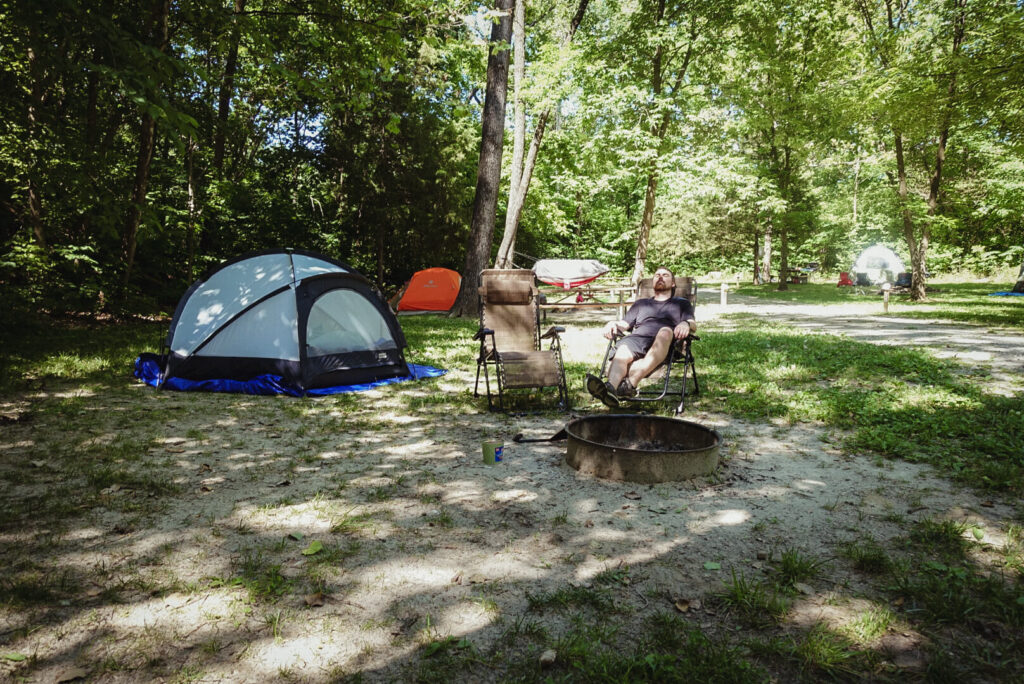
What is Car Camping?
Car camping isn’t exactly how it sounds. You’re not going to be sleeping in your car, I promise! When you car camp, you are carrying your supplies in your car instead of in a backpack. Campsites will have parking spaces close by (or sometimes right next to) your “tent pad,” the designated area at your campsite where you set up your tent. Instead of having to hike all your gear to your campsite, you drive it right up. This allows you to pack bulkier items than if you were camping out of a backpack. This also means that some of the things you’ve already got at home right now are able to be used on your first camping trip!
Reserving a Campsite
When you plan your first camping trip, it would be wise to reserve your campsite in advance. There are many campgrounds that will accept walk-ins, but to guarantee you’ll have a place to stay on your first night camping, I recommend you reserve in advance. Many campgrounds will take reservations online a few days in advance. Some require you to call to reserve.
Due to COVID-19, many campsites this summer are sold out. That means all campsites have been reserved in advance and walk-in campsites are not available. Please call or check online before arriving at a campground.
What is a Primative Campsite?
When you’re booking a reservation, you might notice the words “Primative Campsite” thrown around on the reservation page. Booking a primitive site means you won’t have access to water or electricity at your campsite. At most camp grounds, a primitive site is a plot of ground without any amenities at all. Sometimes, these sites might include a picnic table or a fire ring, but unless it says otherwise, assume these sites have nothing but a place for you to make camp.
What is a Basic Campsite?
You will likely see the option to book “Basic” or “Standard” campsites as well. These sites will typically have a picnic table, a fire ring, and a gravel path leading to your site. Some will even have a place to park your car right at your site. Depending on where you are camping, a basic campsite might also include electricity or water, but do not assume your campsite will have this unless you are told so when reserving.
What is a Full Hookup Site?
A full hookup site means your campsite will have hookups for water, electric and sewage. These sites are typically for RV campers. Having sewage at your campsite does not mean you will have access to a toilet at your campsite, it just means you would have a place to hook up an RV sewage line at this site. If you are tent camping, these amenities are not necessary.
Beginner Camping Packing List
This Tent Camping for Beginners guide is set up for the car campers. This is the easiest and most approachable way to get started camping. You can jump to the bottom of this post to get the free downloadable check list.
Choosing a Tent
The single most important thing to have when you are tent camping is, you guessed it, a tent! You can’t really go wrong with the tent you purchase, but some things you’re going to want to look for are:
- Person Capacity: All tents are categorized by their person capacity (i.e.: 2-person tent, 4-person tent, etc.) Buy a tent for the number of people you’ll be most commonly camping with. If you’ve got a dog tagging along or you would like some extra room at night, add an “extra person” to your count.
- Number of doors: Our tent has two doors, one entrance on each side of the tent. This means we don’t have to climb over one another when entering or exiting the tent. It’s a serious life saver!
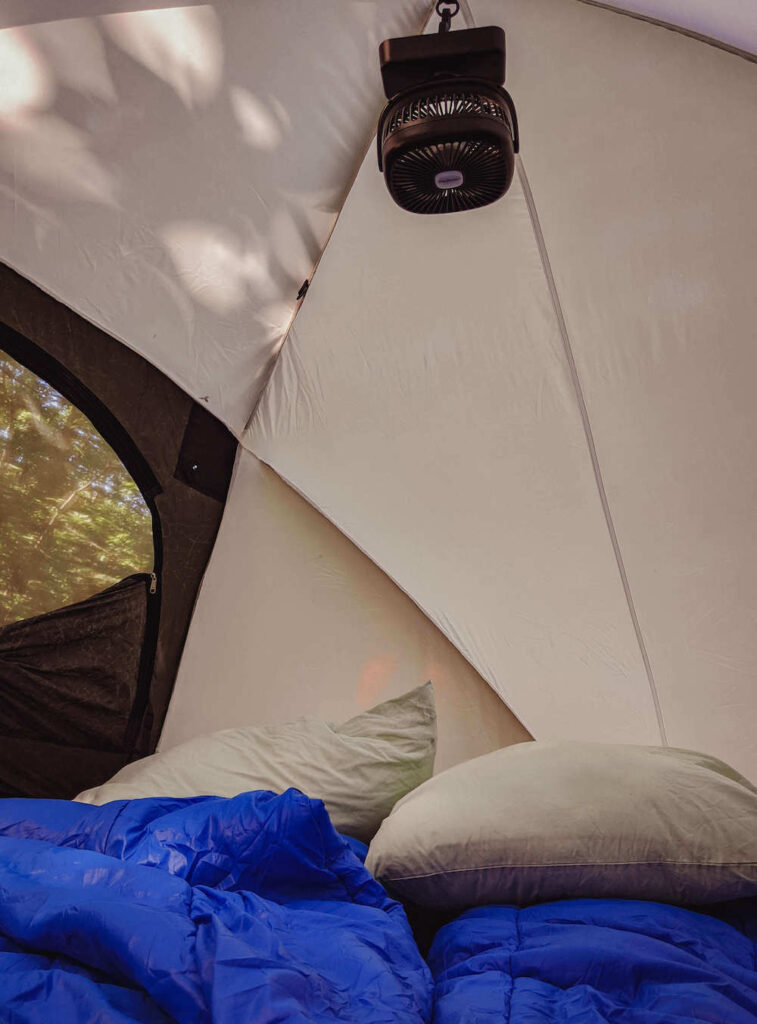
- Air flow: Look for tents that have mesh panels to allow for airflow. It can get very hot very quickly inside of a tent, and if you’re camping in the summer, this can lead to a miserable experience. Tents with more mesh “windows” will make your tent more comfortable to sleep in.
- Interior Pockets: Interior pockets are the little thing that makes a huge difference when camping. Some tents come equip with multiple mesh pockets that hang from the inside walls of the tent. With these, you’ll have a designated place to keep your phone, keys, wallet, camera, maps, whatever you might need to access quickly, and also keep in a safe place when you’re not using it.
Our tent was a hand-me-down from my dad, and is no longer available to buy. But here’s a similar tent from Coleman that will give you all the features of our tent and then some:

Basic Tent Gear
The tent is the most important part, but here are some other necessities for sleeping comfortably:
- A Tarp: use this under your tent to keep it dry and clean.
- A Sleeping Pad or Self-Inflating Mattress: the ground isn’t the most comfortable place to sleep. But with a mattress or sleeping mat, you will be able to sleep well. This is the exact one that we use, I highly recommend them both for comfort and ease of use:

- Sleeping Bags: Sleeping bags are an easy way to pack bedding. If you’re camping in the summertime, be sure to get something that is rated for warm weather! You can skip this one and bring some old bed sheets for one less thing to purchase.
- Camping Fan: This might seem pretty non-essential, but if you’re camping in the summer, you’re going to want to get as much air circulation as possible, and this battery operated fan is absolutely a necessity in my book. Plus, it has a built in LED light, so it serves two purposes. This is the exact one we use:

Click any of the images below to buy the tent supplies mentioned above:
Cooking while Camping Gear
Cooking while camping is not as intimidating as it sounds. Later in this Tent Camping for Beginners Guide, I’m going to cover the basics of how to cook while camping. For now, let’s get you started with the gear you need.
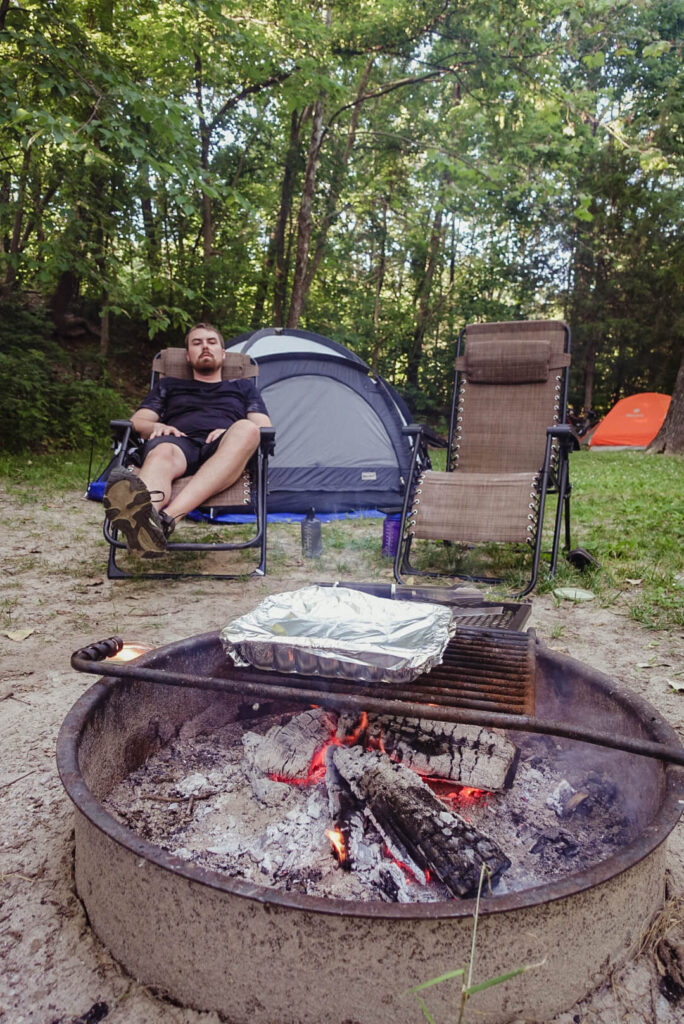
- Camping Grill: many campsite fire rings will have a built in grill, but these are often rusty and I prefer to cook on my own grill. If you’re okay using the provided one, you can easily skip this! This is the exact one we use:

- Grill Brush: Grills are dirty. If you’re going to use the one provided, at least grab a brush to scrape it off first.
- Grill Utensils: Spatula and tongs are a must, everything else is a bonus.
- A really good cooler to keep your perishable foods cold!
- Cast Iron Skillets: If you plan on cooking everything from scratch, you’ll want a set of these. I prefer to cook everything in advance and reheat it over the fire.
- Oven mits & hot pads: So you don’t burn your hands or your table.
- A fire-safe coffee pot: Because there’s nothing better than coffee and camping! If you own a Bialetti coffee pot, you’ve already got something you can use over the fire!
- A camping dish set. We use one like this:

- Firewood: in many states it is illegal to bring wood from out of state, so if you’re crossing state lines, be sure to buy your wood locally.
- A Fire Starter: in case starting a fire from scratch doesn’t go as planned.
- Water: 1 gallon per person per night should have you covered.
- Ice: Lots of it.
Click any of the images below to buy any of the cooking items listed above:
Guide to Cooking While Camping
If this is your first time camping, save yourself some serious stress and make your food in advance! I love to have everything chopped, sliced, and cooked first, and then refrigerate (or freeze) it and simply reheat it on the fire before eating.
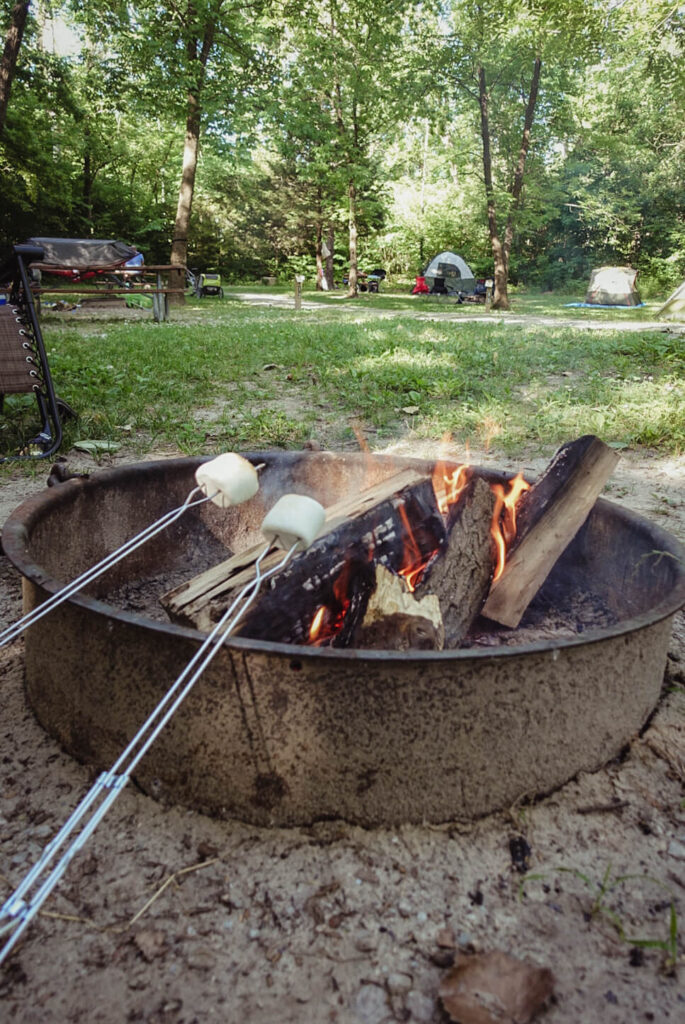
Making a Fire
If you want to make a fire the old fashioned way, you’ll need:
- Dryer Lint. Collect this from your laundry for a few weeks before your trip. It ignites fast and helps the rest of your wood catch fire.
- Tiny twigs. You can collect these from around your campsite if it is allowed, but many places ask that you do not do this. Instead, bring some from home if you live nearby. If not, shave some long strings of wood from your larger longs that you purchased locally.
- Newspaper. Again, this will help everything to catch fire and to take off. If you don’t have newspaper, any recycled paper will do.
- Logs. In some states it is illegal to burn wood from other places. If you are not a local, please buy your wood locally.
Start with Dryer lint and newspaper in the center. Build a pile of tiny twigs around that. Then place three logs in a tee-pee shape around your pile of twigs and lint. Start by lighting the lint on fire. It will catch the newspaper, and then the twigs, and hopefully also the logs! Keep adding twigs until the logs catch.
Once your fire is started, sit back and enjoy it for a bit. You’re not able to cook on it just yet! Your fire needs to get hot first. Once your logs have completely caught on fire and start to glow red with small flames, then you’re ready to put your grill on top and begin cooking. This can take over an hour, so plan ahead!
Beginner Camping Menu
For one night of camping, here’s what we made:
- Day One Lunch: Camping Charcuterie Board. Lots of cheeses, salami, crackers, pickles, grapes, and a couple of dips. Spread it out and make it fancy, or keep it all prepackaged. Be sure you slice everything up before you leave to save time. Bag everything individually and keep cold in your cooler.
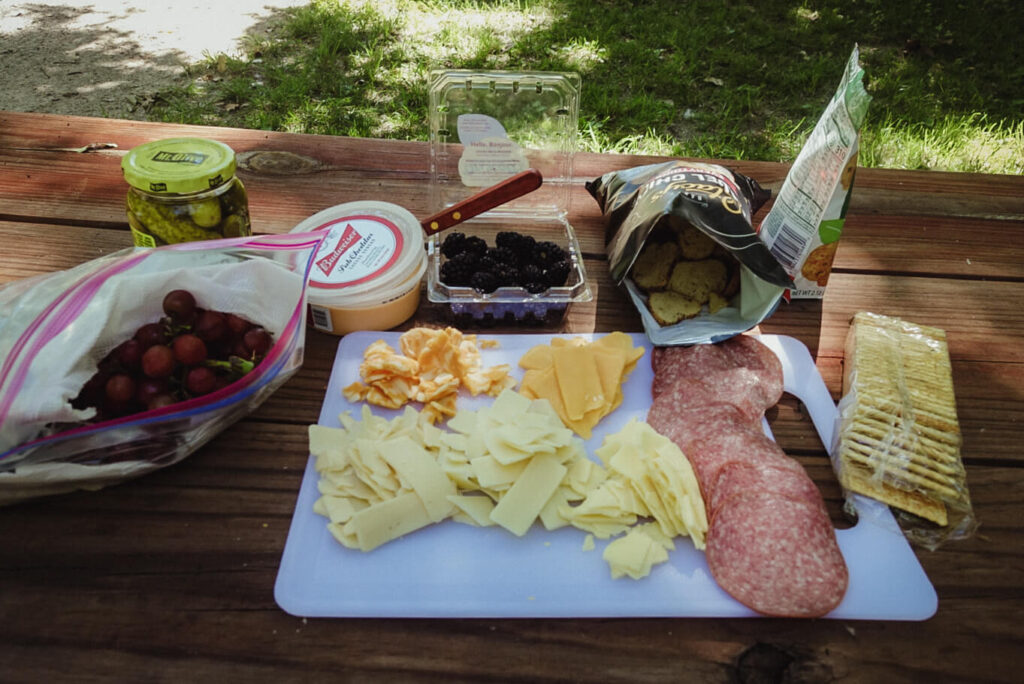
- Day One Dinner: Campfire Mac & Cheese, with a second pass at anything you have left from Lunch. Any of your favorite oven Mac & Cheese recipes will do, but if you’re looking for a suggestion, check out this recipe from Lauren’s Latest. Bring along some sliced peppers to toss right on the grill for a delicious side. We cooked our Mac & Cheese on the grill for 10 minutes and it was perfectly hot. Peppers can be cooked for a few minutes on each side, until grill marks appear.
- Day One Dessert: S’mores, the camping classic.
- Day One Drinks: Serve up some wine with your Lunch Charcuterie board. Create a campfire cocktail for after dinner. This Camp Cocktails book has some great ideas for cocktails you can make while camping. We made one that had you grilling oranges over the campfire, and it was so, so yummy!
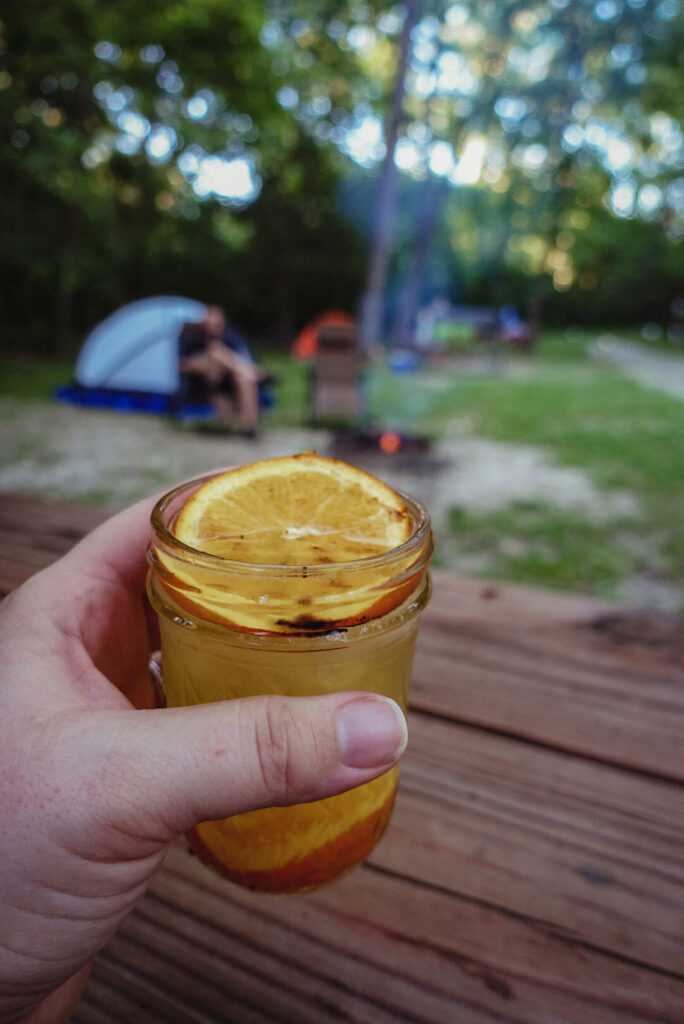
- Day Two Breakfast: Breakfast sandwiches. Eggs, your favorite breakfast meat, cheese, all on a bagel. Wrap it in aluminum foil and stick it on the grill for three minutes on each side. Plus coffee!
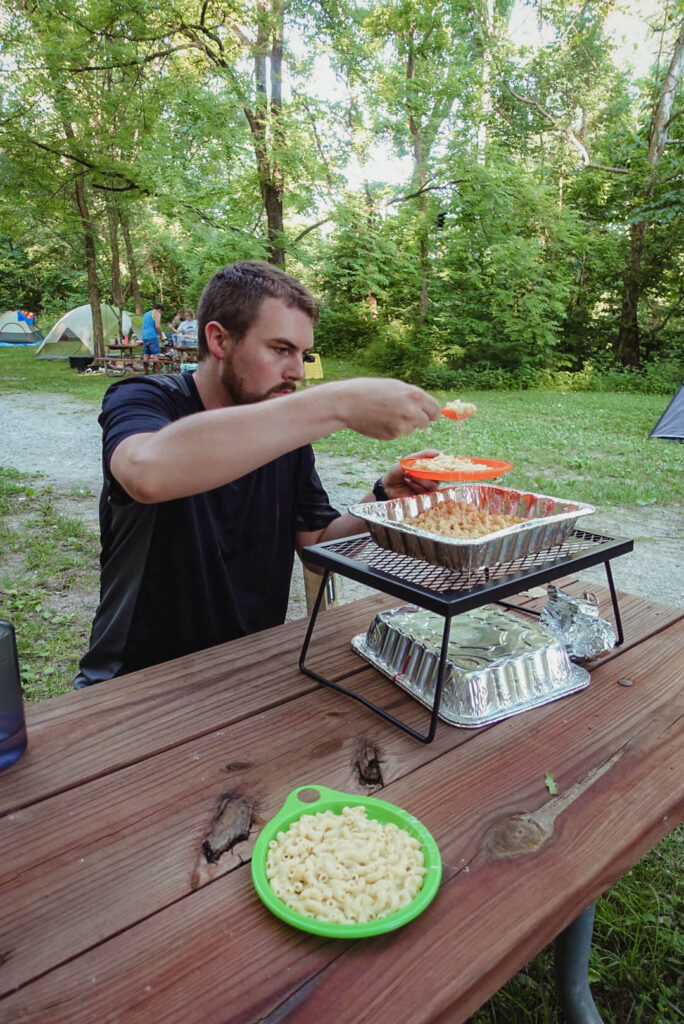
What do I do while camping?
With all of the things tent camping beginners need to think about, things to do while camping isn’t on the top of the list. There are so many things to pack and prepare before camping, you’re not often thinking about what else you’re going to do. Camping is the activity, right? Not quite…
One you’ve got your tent set and your dinner cooking over the fire, what’s next? Here are a few suggestions for things to do while you’re camping.
- Hiking
- Biking
- Board Games
- Playing Cards
- Yard Games
- Fishing
- Kayaking
- Relaxing
If any of these sound like a good activity for you, be sure to pack whatever supplies you’ll need for them! There’s a lot of time to relax and enjoy the outdoors while you’re camping, arrive prepared!
Need an idea for a new yard game to play on your camping trip? We absolutely love playing Kan Jam! Click below to learn more.

Grab Your Tent Camping for Beginners Checklist Below!
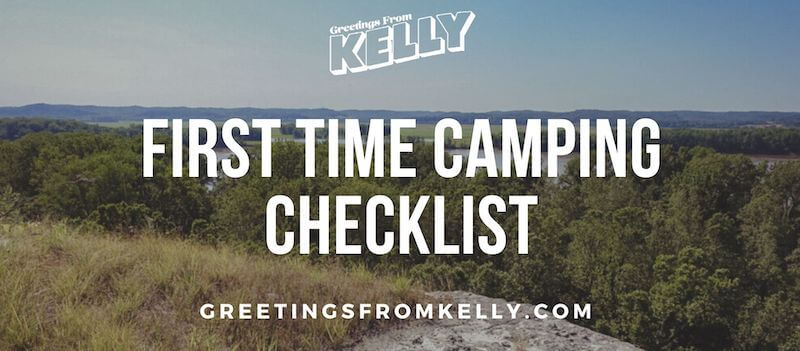

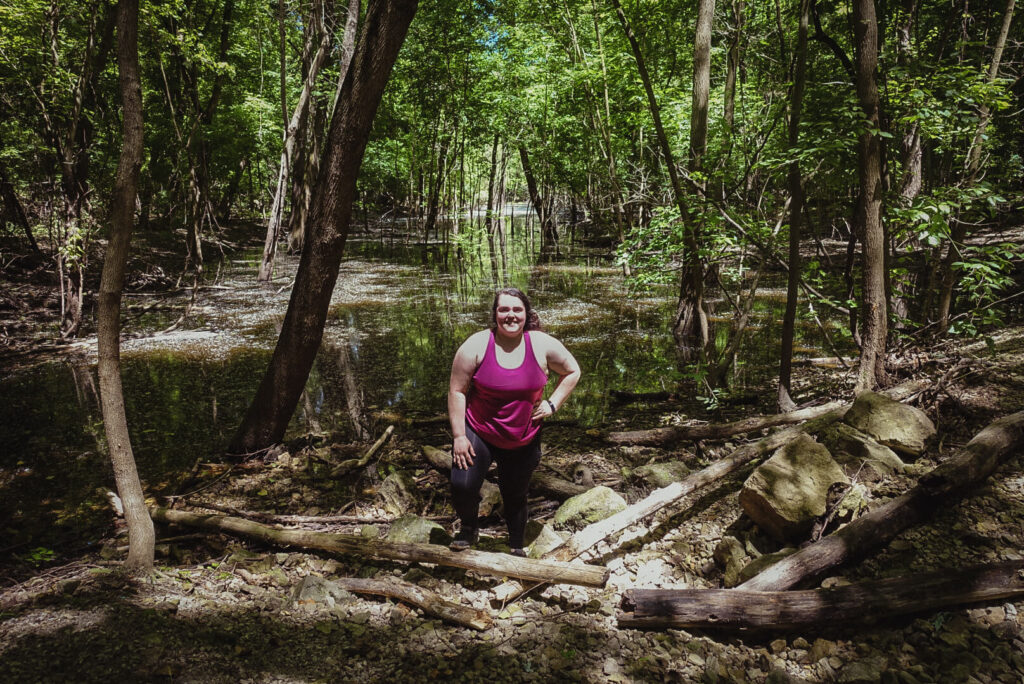
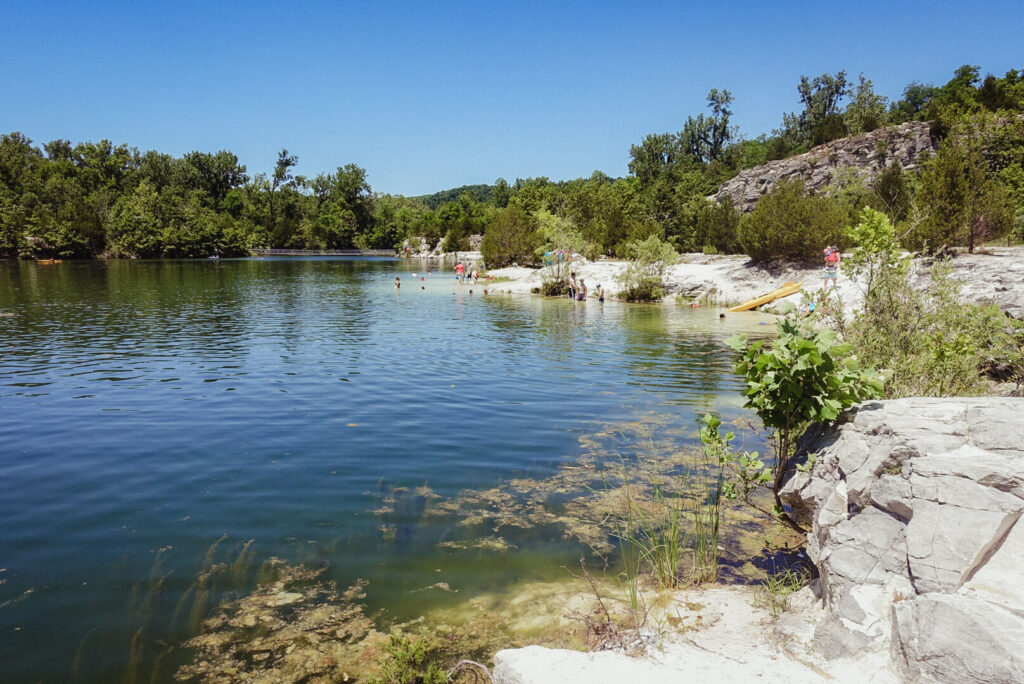

Pin it for Later:


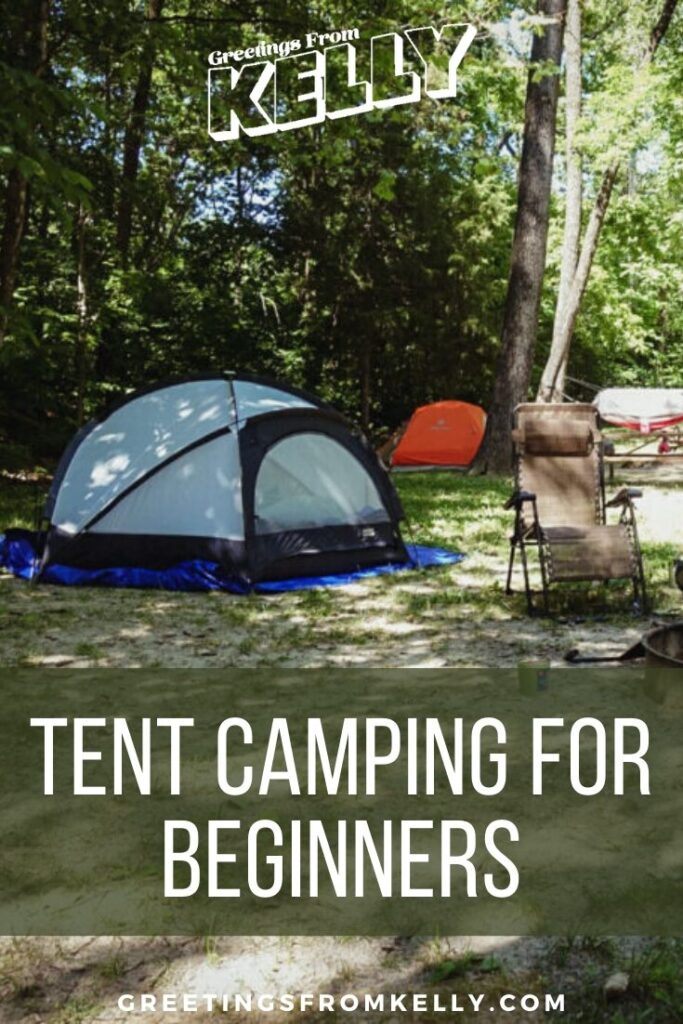
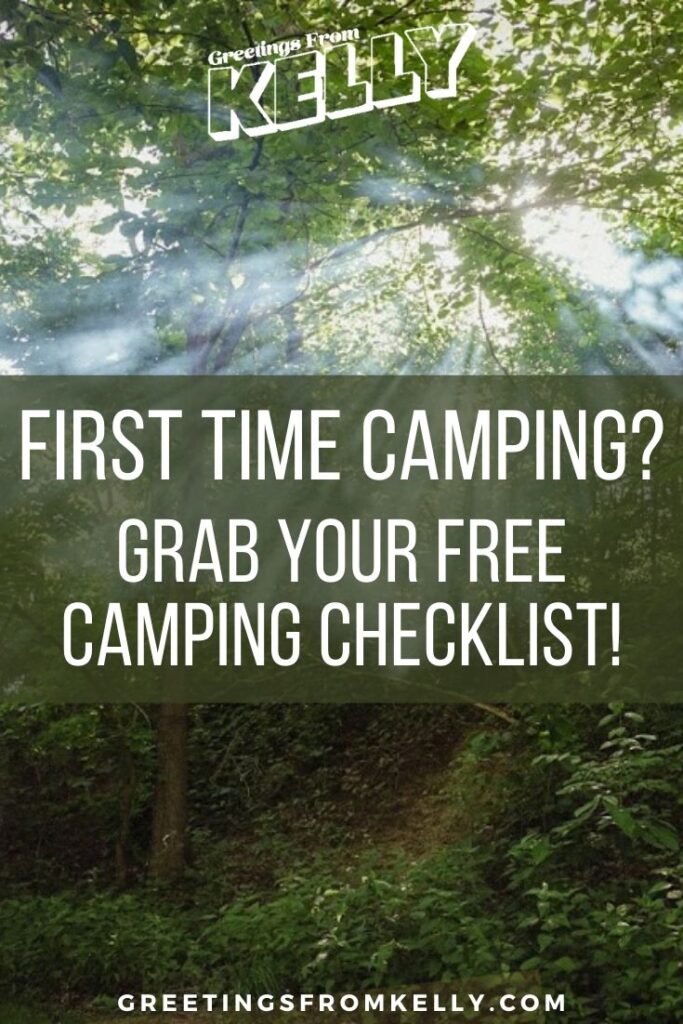
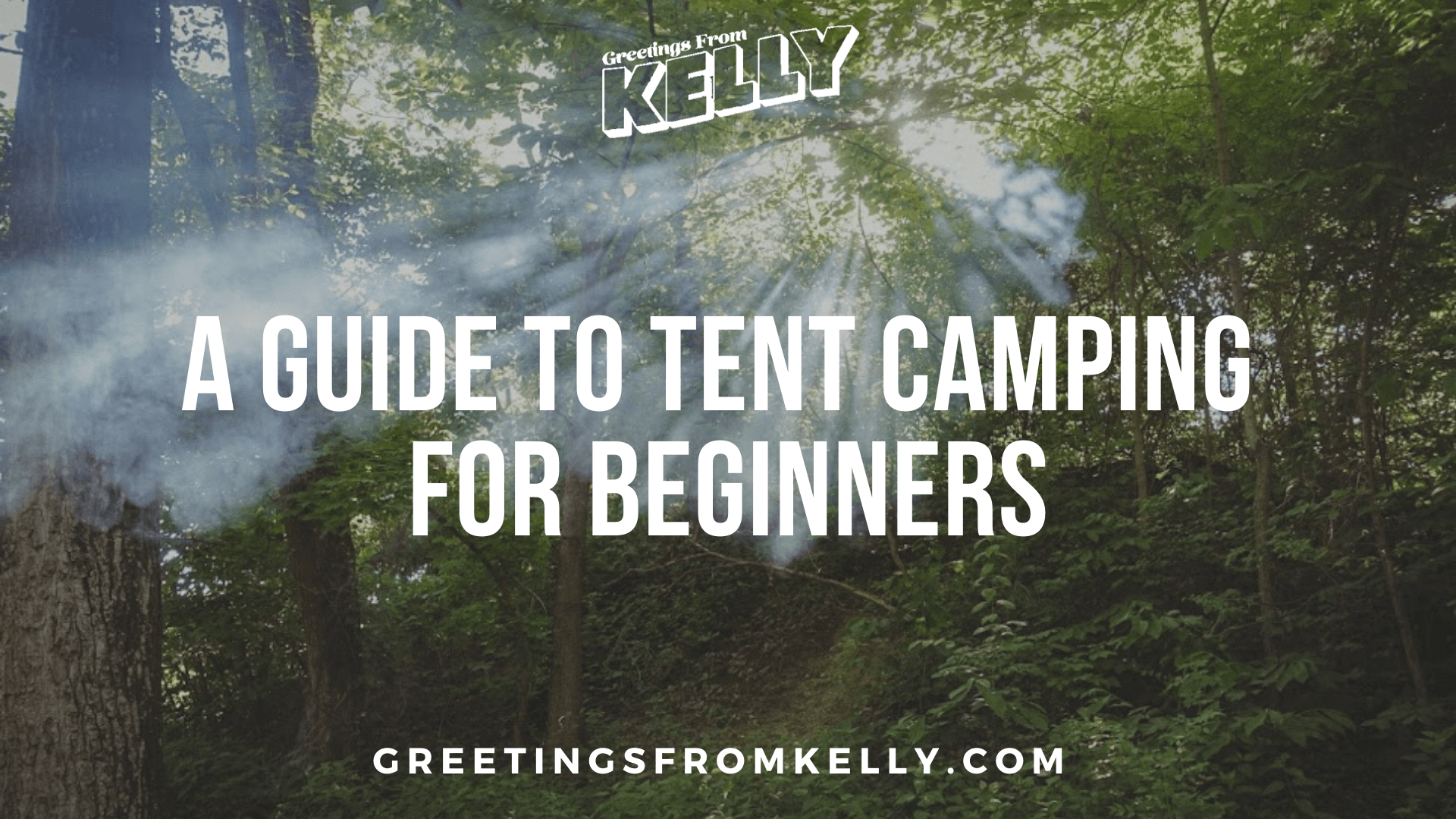
3 thoughts on “The Ultimate Guide to Tent Camping for Beginners”